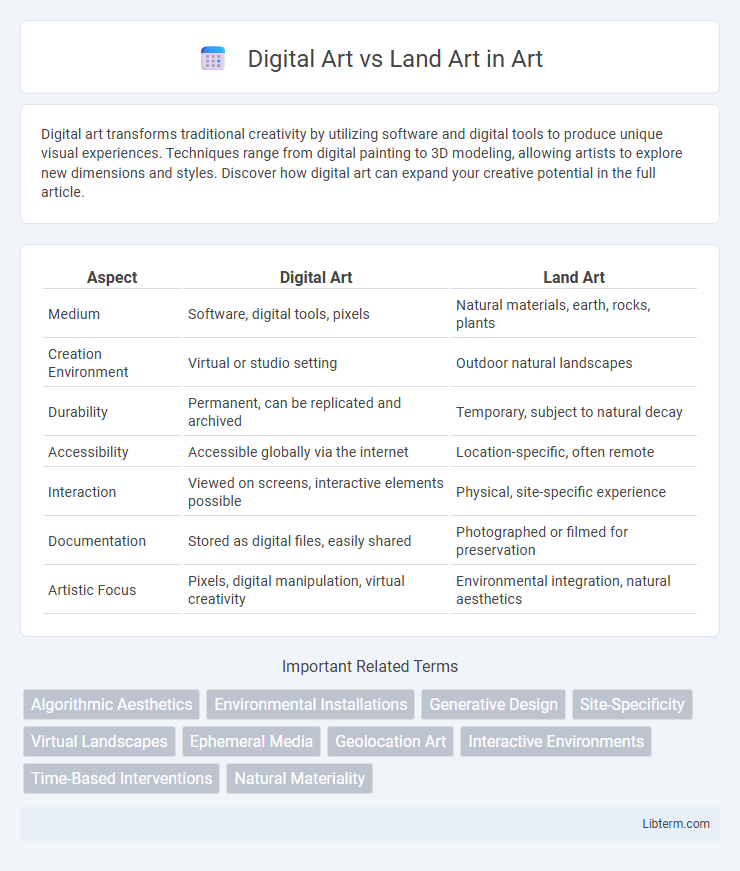Digital art transforms traditional creativity by utilizing software and digital tools to produce unique visual experiences. Techniques range from digital painting to 3D modeling, allowing artists to explore new dimensions and styles. Discover how digital art can expand your creative potential in the full article.
Table of Comparison
| Aspect | Digital Art | Land Art |
|---|---|---|
| Medium | Software, digital tools, pixels | Natural materials, earth, rocks, plants |
| Creation Environment | Virtual or studio setting | Outdoor natural landscapes |
| Durability | Permanent, can be replicated and archived | Temporary, subject to natural decay |
| Accessibility | Accessible globally via the internet | Location-specific, often remote |
| Interaction | Viewed on screens, interactive elements possible | Physical, site-specific experience |
| Documentation | Stored as digital files, easily shared | Photographed or filmed for preservation |
| Artistic Focus | Pixels, digital manipulation, virtual creativity | Environmental integration, natural aesthetics |
Introduction to Digital Art and Land Art
Digital art leverages advanced technology, such as graphic software, virtual reality, and digital tools, to create visually dynamic works that exist primarily in electronic formats. Land art, also known as earth art, involves manipulating natural landscapes and materials--like soil, rocks, and plants--to produce large-scale, site-specific installations that emphasize environmental interaction and temporal change. While digital art emphasizes pixel-based imagery and virtual experiences, land art underscores physical presence and ecological context.
Historical Background of Digital Art
Digital art emerged in the 1960s with the advent of computer technology, marked by early pioneers like Ben Laposky who created computer-generated visuals. The historical background of digital art is rooted in technological innovation, evolving through the development of graphic software, digital imaging, and multimedia tools that transformed traditional artistic methods. This evolution contrasts with land art, which began in the late 1960s as an environmental movement focused on altering natural landscapes.
Evolution and Origins of Land Art
Land Art, originating in the late 1960s, emerged as an artistic movement that transformed natural landscapes into large-scale environmental installations, emphasizing a deep connection between art and nature. Unlike Digital Art, which leverages technology and virtual spaces for creative expression, Land Art's evolution is rooted in ecological awareness, environmental activism, and the desire to challenge traditional gallery confines. Its origins trace back to artists like Robert Smithson and Michael Heizer, who pioneered works that interact directly with the earth, marking a significant shift in the conceptualization of art's relationship to physical space.
Mediums and Techniques: Digital vs Physical
Digital art utilizes software, graphic tablets, and virtual reality tools to create immersive, manipulable artworks that exist primarily in digital formats, enabling seamless editing and replication. In contrast, land art employs natural materials like soil, rocks, and plants, shaped directly within outdoor environments, demanding physical interaction and enduring exposure to natural elements. The techniques in digital art emphasize pixel manipulation, layering, and algorithmic processes, whereas land art relies on sculpting, arranging, and integrating with the landscape to convey temporal and site-specific meanings.
Influential Artists in Digital and Land Art
Influential digital artists such as Refik Anadol and Casey Reas have revolutionized the medium by integrating technology, data visualization, and code to create immersive, interactive experiences. In contrast, land artists like Robert Smithson and Andy Goldsworthy have shaped environmental art through large-scale earthworks and natural material sculptures, emphasizing the temporal and site-specific nature of their creations. Both art forms challenge traditional boundaries, with digital art harnessing virtual space and algorithmic processes, while land art transforms and dialogues with physical landscapes.
Audience Engagement and Accessibility
Digital Art offers interactive experiences through virtual reality, social media, and online platforms, making it highly accessible to global audiences. Land Art, often site-specific and remote, engages viewers through physical presence and environmental interaction, limiting accessibility but deepening experiential connection. Audience engagement in Digital Art is immediate and scalable, whereas Land Art fosters prolonged reflection tied to its natural context.
Conceptual Approaches and Artistic Intent
Digital art employs technology and software to create immersive, malleable experiences that explore virtual spaces and abstract concepts, emphasizing innovation and interactivity. Land art, rooted in physical landscapes, manipulates natural elements to highlight environmental relationships and provoke reflection on human impact and temporality. Both prioritize conceptual depth, but digital art often questions virtual realities while land art grounds meaning in geographic and ecological context.
Environmental Impact and Sustainability
Digital art significantly reduces environmental impact by eliminating the need for physical materials, waste, and transportation emissions commonly associated with land art. Land art, which involves altering natural landscapes using materials like stones, soil, or plants, can disrupt ecosystems and contribute to habitat loss if not carefully managed. Sustainable practices in digital art leverage renewable energy sources for computing power, while eco-conscious land artists prioritize minimal disturbance and restoration efforts to preserve environmental integrity.
Preservation and Longevity of Artworks
Digital art offers enhanced preservation prospects through cloud storage and digital backups, enabling artworks to remain intact without physical degradation. Land art, exposed to natural elements and environmental changes, faces challenges in longevity, often leading to gradual erosion or transformation over time. Conservation efforts in land art require ongoing maintenance and environmental assessments, whereas digital art preservation depends on technological compatibility and data migration strategies.
Future Trends in Digital and Land Art
Future trends in digital art emphasize the integration of augmented reality (AR), virtual reality (VR), and artificial intelligence (AI) to create immersive and interactive experiences. Land art continues to evolve with eco-friendly practices, incorporating sustainable materials and environmental restoration to blend artistic expression with ecological responsibility. Both art forms increasingly explore the fusion of technology and nature, pushing boundaries in experiential and site-specific creativity.
Digital Art Infographic

 libterm.com
libterm.com